The new year begins and along with it comes the usual spate of information on how to lose weight, how to do your taxes and how to clean out all the stuff that is in your house. Driving to Spokane I notice a lot more huge apartment buildings and a lot of big houses built too close together for my taste. Along with the new living spaces there are also major new self-storage facilities. While out under the snow microbes are busy breaking down last year’s organic matter into soil for the new growing season, we are inside coming face to face with our stuff.
Being maybe a little too obsessed with history, I tend to ask how is this different than a hundred years ago and how did it get to be this way. For most of human history all we had to work with were sticks, stones and some animal parts. Then we got into metals. They are a big deal. But even metals, if you ignore the part about mining and chemical extraction, tend to be easy to recycle and valuable that way. One way to see the difference is to look at what’s left after a hurricane like Ian: huge piles of broken lumber, metal roofing, dry wall, fiberglass insulation, asphalt roofing, pieces of concrete, lots of clothing and appliances, a few cars too.

Since a lot of the destruction is on expensive beach-front property, you can expect that it will soon be loaded into dump trucks and carted off to the local landfill. There it will be mixed with the rest of our waste. The top items in a landfill according sciencefocus.com are: Paper: 27%, Food Waste: 14.6%, Yard Waste: 13.5%, Plastics: 12.8%, Metals: 9.1%, Rubber, Leather, and Textiles: 9%, Wood: 6.2%, Glass: 4.5%, Other: 3.3%. So here we have a microcosm of our whole manufactured world. The good news is that 75% of it can be recycled. The bad news is that 25% is very hard-to-recycle and the worse news is that only 15% of stuff that can be recycled actually is.
The 25% hard-to-recycle parts are mostly clothing and plastics. Clothing caught my eye because more than one article I saw mentioned the 59,000 tons of clothing that are shipped to the Adacama desert in Chile every year where it will last virtually forever.
There are good do-it-yourself suggestions out there. The “Buy Nothing, Get Everything Shareocracy” recommends the “3 R’s”: Reduce, Reuse, Recycle. But their favorite is Refuse. In other words, don’t buy it in the first place. Almost 80% of unwanted textiles end up in a landfill (abc.net.au). Another “R” would be to Repair. Loved Clothes Last, a book by Castro Orsola, gives details on repairing clothes. Even theoretically recyclable cloth such as cotton has an environmental cost before it gets sold. It takes 2,700 liters of water to make a cotton shirt according to the World Resources Institute.

Plastic is a big deal in landfills and even bigger at sea where incredibly the International Atomic Energy Agency (www.iaea.org) estimates that by 2050 there will be more plastic in the ocean than fish. 90% of seabirds have eaten plastic according to the National Academy of Science (www.pnas.org). In my vision for a brave new regenerative world, “Compost Everything” might be the war cry.
Progress is being made on composting plastics. Some excitement was generated when the Japanese Kyoto Institute of Technology found a bacteria, ideonella sakaiensis, that had evolved to digest PET (polyethylene terephthalate or Polyester) plastics, the kind found in water bottles and a lot of food containers. Listening to a video by Dr. Ben Miles about this discovery I learned that these bacteria only work on thin bottles or films. But their enzymes are a useful start. To get “soft crystalline” bottles and the “hard crystalline” food containers to biodegrade, a company in France, Carbios, has developed enzymes that can be used in a large commercial facility to break the long polymers of PET into small pieces that can be reused to make new plastic. Without that step, even recycled plastics become less and less reusable after every recycle.
On the other hand, many plastic knives and forks labelled as “compostable” are not. There is no government oversite of that label. The Oregon Department of Environmental Quality found that often so-called “compostable” serviceware had a higher environmental impact than non-compostable. The private Biodegradable Products Institute checks on biodegradability, and you can trust the BPI label.
Since 75% of the material in landfills could be recycled but has not been, recycling is obviously not working. A lot of energy and research is focused on these issues, but you don’t see much being said about it unless you look. The companies that make money from these products are not inclined to advertise about the issues. It is not a political hot-button issue, so it doesn’t make the news cycle. I am associating it with Critical Race Theory as something people seldom discuss, and that vested interests emphatically discourage discussing.
Imagining the result will be something akin to the world inhabited by Wall-E, the trash robot, I googled Wall-E to check the spelling. The first thing that came up was a very-hard-to recycle plastic toy version of Wall-E available at Target for $54. We’re doomed.
